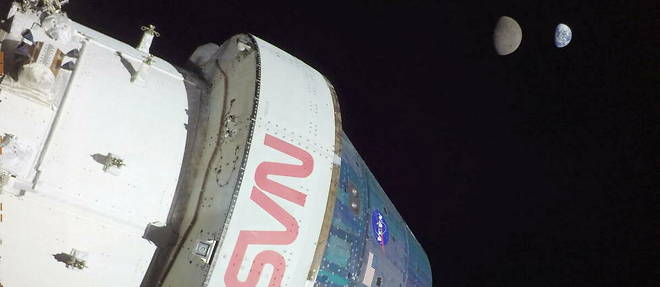NASA’s Orion capsule is due to splash down in the Pacific Ocean on Sunday, after visiting the Moon and venturing further into space than any habitable craft before it. This landing marks the last stage of the Artemis I mission with enormous stakes for the American space agency. The capsule will enter the Earth’s atmosphere at a speed of 40,000 km/h, and will have to withstand the infernal heat of 2,800°C, half the temperature of the surface of the Sun. The landing is scheduled off the Mexican island of Guadalupe at 9:39 a.m. local time.
The success of this mission, which lasted a little over 25 days in total, is crucial for NASA, which has invested tens of billions of dollars in the American program to return to the Moon, Artemis, whose goal is to prepare for a future trip to Mars. The first test flight of this brand new vehicle, this time without an astronaut on board, has so far been a real success. But it is only during the last minutes of the mission that its main objective must be accomplished: testing the capsule’s heat shield, the largest ever built (5 m in diameter).
A US Navy ship, the USS Portland, has been pre-positioned for capsule recovery operations, which NASA has been training for years. Helicopters and inflatable boats will also be deployed. The spacecraft will first be slowed down by the Earth’s atmosphere, then by a series of no less than eleven parachutes, until it reaches a speed of around 30 km/h when it hits the water. Once landed, it will be left in the water for two hours, much longer than if astronauts were on board, in order to collect data.
In total, the spacecraft will have traveled more than 2.2 million kilometers in space since its liftoff on November 16 during the first flight of NASA’s new mega-rocket, SLS. Orion flew past the Moon just some 130 kilometers from its surface, and ventured over 430,000 km from our planet.
Recovering the capsule will allow the collection of a lot of decisive data for the following missions. First by detailing the state of the ship after its trip, but also by analyzing the recordings of sensors of the accelerations and vibrations undergone on board, or the performance of an anti-radiation jacket. Some elements of the ship must also be reused for the Artemis II capsule, which is already well advanced. This second mission, scheduled for 2024, will take a crew to the Moon, still without landing there. NASA should announce the names of the chosen astronauts very soon.
The Artemis program must this time send the first woman and the first person of color there. NASA’s goal is to establish a lasting human presence on the Moon, with a base on its surface and a space station orbiting it. Learning to live on the Moon should test all the technologies needed for a multi-year journey to Mars – possibly in the late 2030s.


















